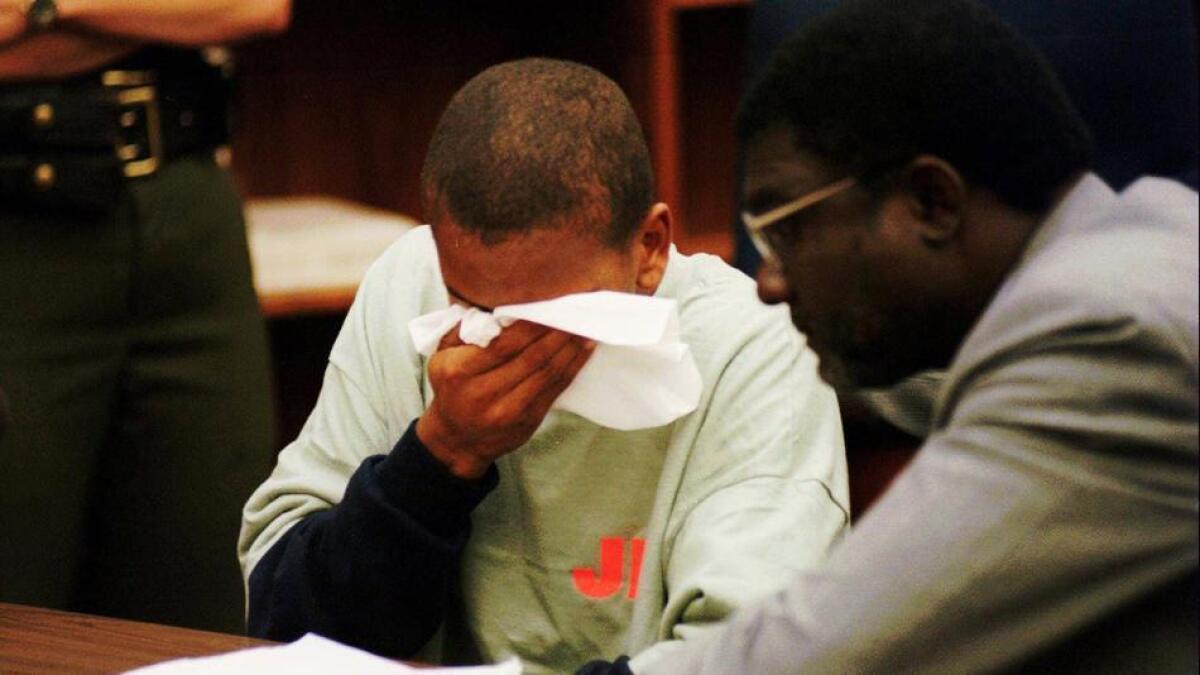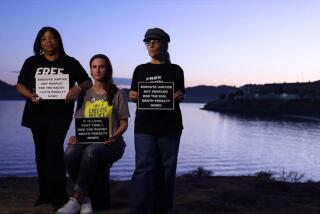At 14, he killed a man in a botched robbery. Now 38, he has a chance at parole

- Share via
Reporting from San Diego — Tony Hicks was 14 when he killed a pizza delivery driver in a botched robbery.
Now 38, he will get his first chance at parole.
But is Hicks suitable for release? A former district attorney says yes. So does the judge who sentenced him to 25 years to life in prison.
Most notable among those who support him is Azim Khamisa, father of the San Diego State University student Hicks killed.
Hicks was still in junior high school when the killing occurred on Jan. 21, 1995 — 21 days after a change in the law allowed prosecutors to try a juvenile as young as 14 as an adult.
He was the youngest Californian at that time to face that legal fate. Eventually, the teen faced a San Diego judge and admitted killing Tariq Khamisa in a robbery gone wrong.
“I’m sorry for killing Tariq and his family,” he told the sentencing judge in 1996. “My grandfather promised me that he will be Mr. [Azim] Khamisa’s friend and help him in any way he can for the rest of his life.”
Promise kept. Grieving father Azim Khamisa teamed with Ples Felix, Hicks’ grandfather and guardian, to create the Tariq Khamisa Foundation, or TKF, an organization devoted to stopping gang violence.
That kept promise may be one of the biggest factors in Hicks’ potential release.
Tariq Khamisa was 20, a full-time college student and a part-time pizza delivery driver in North Park when a bullet fired during a robbery ended his life.
The skinny Hicks was known to some at the time as “Bone,” a 5-foot4 junior high school student, when he fired the 9-millimeter handgun that killed Tariq Khamisa. The shooting came at the urging of an 18-year-old fellow gang member, the San Diego Union-Tribune reported in 1996.
By the time he pleaded guilty, Hicks was 15. He entered the prison system for juveniles.
The next year, the state relocated its 16- and 17-year-old inmates, taking them from youth prisons and putting them in with adults. At 16, Hicks was at Folsom State Prison.
He was 21 when he stabbed a prison guard with an 8-inch shank in 2002, authorities said.
District Attorney Summer Stephan said she can’t ignore that part of Hicks’ record.
“That is a serious violent offense, and that is several years after the murder when he was already an adult,” she said. “I have to weigh the real compelling interest of how old he is but also public safety … and if he is ready for parole.”
Typically, prosecutors formally oppose parole at an inmate’s first hearing, especially if that person has committed a violent act in prison.
The district attorney’s office has not taken a position in Hicks’ case. Not yet.
In Hicks’ favor, Stephan said, are his age at the time of the crime, that he has been free of violations in prison for a few years, and the support he has on the outside.
At the request of the victim’s family, Stephan will attend Hicks’ parole hearing Wednesday in San Luis Obispo.
“I am going to listen and weigh and keep an open mind,” Stephan said, “and hopefully hear enough information that he is ready.”
She said she is mindful of the work of TKF, established by the victim’s father and the killer’s grandfather.
“They have turned their pain into optimism,” she said.
Azim Khamisa and Felix were working on restorative justice — the idea that reconciliation with victims furthers rehabilitation of the offender — before it became a movement.
The Tariq Khamisa Foundation has great reach in San Diego County. The organization’s website says it has connected with more than 500,000 young people across the county since 1995 with a goal of stopping teen violence.
In November 2017, the founders gave a TED talk at a conference in New Orleans telling their story. The transcript of their presentation was translated into 17 languages.
Hicks has earned a high school diploma and college credits in prison. He’s also been writing a blog for TKF’s website, speaking of the “shame of his actions” and the “destructive impact” he had.
The blog contains answers to questions from students. It includes what is essentially an open letter to his victim, written earlier this year. It reads, in part:
“I can’t comprehend what you must have felt that night I ambushed you, turning around to see me standing there with a loaded gun pointing at you demanding the pizza that you had already returned to the back of your car. You were courageous in that moment refusing to allow yourself to be robbed and for standing for what was right.
“I often wonder if I would have your strength now? I know that I didn’t have it then. I was scared and weak inside trying to hide those feelings and others behind the mask that being a part of a gang provided me and the gun that I pointed at you.”
If Hicks is granted parole, he won’t get out until next year. And if he is released in 2019, a coming change to the law gives his case notable bookends.
On New Year’s Day in 1995 — 21 days before the killing of Tariq Khamisa — state law changed to allow juveniles as young as 14 to be tried for murder.
On New Year’s Day 2019, that’s no longer the case. Under a new law, no one under 16 can be charged as an adult in California for any crime.
teri.figueroa@sduniontribune.com
More to Read
Sign up for Essential California
The most important California stories and recommendations in your inbox every morning.
You may occasionally receive promotional content from the Los Angeles Times.













